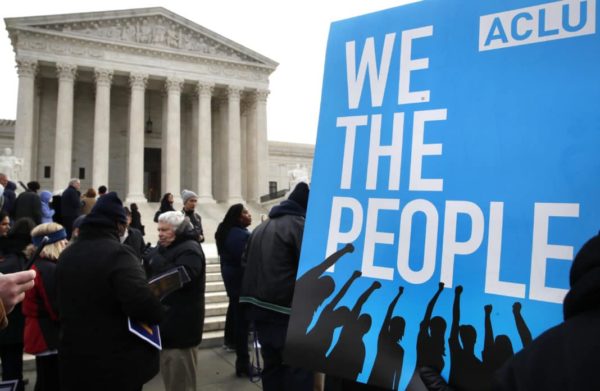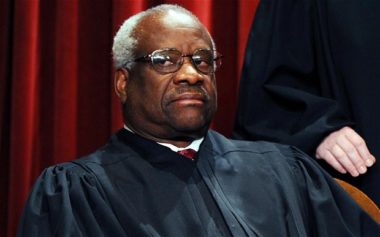
People rally outside of the Supreme Court in opposition to Ohio’s voter roll purges in Washington. The Supreme Court is allowing Ohio to clean up its voting rolls by targeting people who haven’t cast ballots in a while. (AP Photo/Jacquelyn Martin, File)
WASHINGTON (AP) — The Supreme Court ruled Monday that states can clean up their voting rolls by targeting people who haven’t cast ballots in a while, a case that has drawn attention amid stark partisan divisions and the approach of the 2018 elections.
By a 5-4 vote that split the conservative and liberal justices, the court rejected arguments in a case from Ohio that the practice violates a federal law intended to increase the ranks of registered voters. A handful of other states also use voters’ inactivity to trigger a process that could lead to their removal from the voting rolls.
Justice Samuel Alito said for the court that Ohio is complying with the 1993 National Voter Registration Act. He was joined by his four conservative colleagues.
The four liberal justices dissented.
Partisan fights over ballot access are being fought across the country. Democrats have accused Republicans of trying to suppress votes from minorities and poorer people who tend to vote for Democrats. Republicans have argued that they are trying to promote ballot integrity and prevent voter fraud.
Under Ohio rules, registered voters who fail to vote in a two-year period are targeted for eventual removal from registration rolls, even if they haven’t moved and remain eligible. The state said it only uses the disputed process after first comparing its voter lists with a U.S. postal service list of people who have reported a change of address. But not everyone who moves notifies the post office, the state said.
So the state asks people who haven’t voted in two years to confirm their eligibility. If they do, or if they show up to vote over the next four years, voters remain registered. If they do nothing, their names eventually fall off the list of registered voters.
“Combined with the two years of nonvoting before notice is sent, that makes a total of six years of nonvoting before removal,” Alito wrote.
Justice Stephen Breyer, writing in dissent, said the 1993 law prohibits removing someone from the voting rolls “by reason of the person’s failure to vote. In my view, Ohio’s program does just that.”
In a separate dissent, Justice Sonia Sotomayor said Congress enacted the voter registration law “against the backdrop of substantial efforts by states to disenfranchise low-income and minority voters.” The court’s decision essentially endorses “the very purging that Congress expressly sought to protect against,” Sotomayor wrote.
Civil rights groups said the court should be focused on making it easier for people to vote, not allowing states to put up roadblocks to casting ballots.
“With the midterm election season now underway, the court’s ruling demands heightened levels of vigilance as we anticipate that officials will read this ruling as a green light for loosely purging the registration rolls in their community,” said Kristen Clarke, president and executive director of the Lawyers’ Committee for Civil Rights Under Law.
Ohio has used voters’ inactivity to trigger the removal process since 1994, although groups representing voters did not sue the Republican secretary of state, Jon Husted, until 2016. As part of the lawsuit, a judge last year ordered the state to count 7,515 ballots cast by people whose names had been removed from the voter rolls.
Husted called the decision “a victory for electoral integrity.” He is running for lieutenant governor this November on the Republican ticket headed by Mike DeWine, the current attorney general.
Adding to the tension in the case, the Trump administration reversed the position taken by the Obama administration and backed Ohio’s method for purging voters.
Last week, President Donald Trump said he would nominate Eric Murphy, the Ohio lawyer who argued the case on the state’s behalf, to a seat on the Cincinnati-based 6th U.S. Circuit Court of Appeals. A three-judge panel on that court had ruled 2-1 that Ohio’s practice was illegal.


